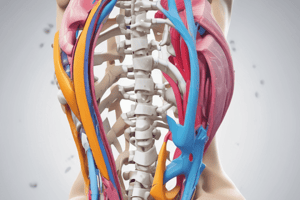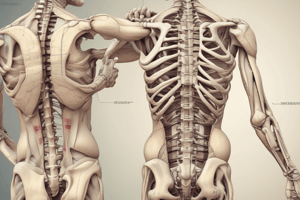Podcast
Questions and Answers
According to Fryette's laws, what happens when the spine is in a neutral position and side-bending occurs to one side?
According to Fryette's laws, what happens when the spine is in a neutral position and side-bending occurs to one side?
- Flexion occurs simultaneously.
- Extension occurs simultaneously.
- Horizontal rotation occurs to the same side.
- Horizontal rotation occurs to the opposite side. (correct)
Which statement best describes Fryette's third law?
Which statement best describes Fryette's third law?
- Side-bending and rotation always occur to the same side, regardless of spinal position.
- Motion in one plane of the spine does not affect motion in other planes.
- Introducing motion in one plane will modify motion in the other two planes. (correct)
- Motion in one plane of the spine enhances motion in other planes.
In the context of spinal instability, how does the neural zone (NZ) behave relative to the pain-free zone (PFZ)?
In the context of spinal instability, how does the neural zone (NZ) behave relative to the pain-free zone (PFZ)?
- The Neural Zone is thought to increase over the Pain Free Zone limits in an unstable spine. (correct)
- The Neural Zone remains constant with changes to the Pain Free Zone in an unstable spine.
- The Neural Zone decreases over the Pain Free Zone limits in an unstable spine.
- The Neural Zone is unrelated to the Pain Free Zone.
Which of the following contributes to the passive stabilization of the spine?
Which of the following contributes to the passive stabilization of the spine?
What is the role of mechanoreceptors in spinal stabilization?
What is the role of mechanoreceptors in spinal stabilization?
What key process defines neuromuscular control in maintaining joint stability?
What key process defines neuromuscular control in maintaining joint stability?
Which of the following is an example of feedforward neuromuscular control?
Which of the following is an example of feedforward neuromuscular control?
How does lumbar segmental instability primarily contribute to chronic low back pain?
How does lumbar segmental instability primarily contribute to chronic low back pain?
What is the primary characteristic of spinal segmental instability?
What is the primary characteristic of spinal segmental instability?
Which factor is LEAST likely to be associated with lumbar segmental instability?
Which factor is LEAST likely to be associated with lumbar segmental instability?
Which of the following best describes spinal stability, according to Vleeming et al. (2008)?
Which of the following best describes spinal stability, according to Vleeming et al. (2008)?
Clinical stability of the spine is characterized by:
Clinical stability of the spine is characterized by:
The neutral zone (NZ) of intervertebral motion is best described as:
The neutral zone (NZ) of intervertebral motion is best described as:
Which of the following is true of the elastic zone (EZ) in spinal motion?
Which of the following is true of the elastic zone (EZ) in spinal motion?
The helical axis of motion (HAM) is useful because:
The helical axis of motion (HAM) is useful because:
Coupled motion in the spine refers to:
Coupled motion in the spine refers to:
Which motion typically exhibits coupled behavior in the spine?
Which motion typically exhibits coupled behavior in the spine?
Why is it difficult for pure lateral flexion and pure rotation to occur in the spine?
Why is it difficult for pure lateral flexion and pure rotation to occur in the spine?
During the transition from a bipedal to unipedal stance, what compensation is likely observed in a patient with lumbar segmental instability?
During the transition from a bipedal to unipedal stance, what compensation is likely observed in a patient with lumbar segmental instability?
Which characteristic is most indicative of a multi-directional pattern of lumbar instability?
Which characteristic is most indicative of a multi-directional pattern of lumbar instability?
During a palpatory examination, what finding would suggest lumbar segmental instability at a symptomatic level?
During a palpatory examination, what finding would suggest lumbar segmental instability at a symptomatic level?
In the context of lumbar movement control dysfunction, what is the primary focus of the initial stage of training?
In the context of lumbar movement control dysfunction, what is the primary focus of the initial stage of training?
What is the focus when training isometric co-contraction of the transversus abdominis and lumbar multifidus in the early stages of rehabilitation?
What is the focus when training isometric co-contraction of the transversus abdominis and lumbar multifidus in the early stages of rehabilitation?
What is a common symptom across all four clinical patterns of lumbar dysfunction?
What is a common symptom across all four clinical patterns of lumbar dysfunction?
A patient presents with central back pain, experiences an arc of pain during flexion, and requires the use of their hands to return to a neutral position. Which clinical pattern does this presentation align with?
A patient presents with central back pain, experiences an arc of pain during flexion, and requires the use of their hands to return to a neutral position. Which clinical pattern does this presentation align with?
Which of the following is a key characteristic of the extension pattern of lumbar dysfunction?
Which of the following is a key characteristic of the extension pattern of lumbar dysfunction?
In the context of the lateral shift pattern, what is commonly observed when palpating the lumbar multifidus muscles?
In the context of the lateral shift pattern, what is commonly observed when palpating the lumbar multifidus muscles?
A patient with a lateral shift pattern exhibits a loss of lumbar lordosis and a lateral shift at the affected level. Which movement is most likely to exacerbate their symptoms?
A patient with a lateral shift pattern exhibits a loss of lumbar lordosis and a lateral shift at the affected level. Which movement is most likely to exacerbate their symptoms?
During assessment, a patient with a suspected extension pattern demonstrates a tendency to hold their lumbar spine in lordosis during flexion, followed by a sudden loss of lordosis in the midrange, along with an arc of pain. How would you expect them to return to a neutral position?
During assessment, a patient with a suspected extension pattern demonstrates a tendency to hold their lumbar spine in lordosis during flexion, followed by a sudden loss of lordosis in the midrange, along with an arc of pain. How would you expect them to return to a neutral position?
A patient is diagnosed with lower cross syndrome. Based on this diagnosis, which of the following muscle imbalances is most likely?
A patient is diagnosed with lower cross syndrome. Based on this diagnosis, which of the following muscle imbalances is most likely?
What common compensatory strategy might you observe in a person with a flexion pattern?
What common compensatory strategy might you observe in a person with a flexion pattern?
What is the primary focus of the associative stage of motor learning?
What is the primary focus of the associative stage of motor learning?
During the associative stage, what is the recommended approach for addressing faulty movement patterns?
During the associative stage, what is the recommended approach for addressing faulty movement patterns?
What type of exercise is encouraged during the associative stage to aid in automaticity of movement patterns?
What type of exercise is encouraged during the associative stage to aid in automaticity of movement patterns?
In what situations are patients encouraged to perform co-contractions during the associative stage?
In what situations are patients encouraged to perform co-contractions during the associative stage?
What is the typical duration of the associative stage of motor learning?
What is the typical duration of the associative stage of motor learning?
What characterizes the autonomous stage of motor learning?
What characterizes the autonomous stage of motor learning?
Why is pain control emphasized during the component movement practice in the associative stage?
Why is pain control emphasized during the component movement practice in the associative stage?
Which of the following videos would be MOST helpful to examine lumbar segmental instability?
Which of the following videos would be MOST helpful to examine lumbar segmental instability?
Flashcards
Neuromuscular control
Neuromuscular control
Involuntary activation of muscles and nerves for joint stability during movement.
Feedforward control
Feedforward control
Muscle preparation in advance of movement to maintain stability.
Feedback control
Feedback control
Muscle adjustments in response to actual movement or load changes.
Lumbar segmental instability
Lumbar segmental instability
Signup and view all the flashcards
Spinal segmental instability
Spinal segmental instability
Signup and view all the flashcards
Fryette's Law 1
Fryette's Law 1
Signup and view all the flashcards
Fryette's Law 2
Fryette's Law 2
Signup and view all the flashcards
Fryette's Law 3
Fryette's Law 3
Signup and view all the flashcards
Spinal Instability
Spinal Instability
Signup and view all the flashcards
Active Stabilization
Active Stabilization
Signup and view all the flashcards
Clinical Stability
Clinical Stability
Signup and view all the flashcards
Physiologic Range of Motion (ROM)
Physiologic Range of Motion (ROM)
Signup and view all the flashcards
Neutral Zone (NZ)
Neutral Zone (NZ)
Signup and view all the flashcards
Elastic Zone (EZ)
Elastic Zone (EZ)
Signup and view all the flashcards
Helical Axis of Motion (HAM)
Helical Axis of Motion (HAM)
Signup and view all the flashcards
Coupled Motions
Coupled Motions
Signup and view all the flashcards
Lateral Flexion and Rotation
Lateral Flexion and Rotation
Signup and view all the flashcards
Bipedal to Unipedal Stance
Bipedal to Unipedal Stance
Signup and view all the flashcards
Multi-directional Pattern
Multi-directional Pattern
Signup and view all the flashcards
Symptomatic Hypermobile Motion Segment
Symptomatic Hypermobile Motion Segment
Signup and view all the flashcards
Dynamic Stability in Lumbar Rehabilitation
Dynamic Stability in Lumbar Rehabilitation
Signup and view all the flashcards
Cognitive Stage of Training
Cognitive Stage of Training
Signup and view all the flashcards
Associative stage of motor learning
Associative stage of motor learning
Signup and view all the flashcards
Movement component repetition
Movement component repetition
Signup and view all the flashcards
Pain control during training
Pain control during training
Signup and view all the flashcards
Increase in speed and complexity
Increase in speed and complexity
Signup and view all the flashcards
Aerobic exercise in training
Aerobic exercise in training
Signup and view all the flashcards
Co-contraction during instability
Co-contraction during instability
Signup and view all the flashcards
Duration of the associative stage
Duration of the associative stage
Signup and view all the flashcards
Autonomous stage of motor learning
Autonomous stage of motor learning
Signup and view all the flashcards
Clinical Patterns
Clinical Patterns
Signup and view all the flashcards
Four Clinical Patterns
Four Clinical Patterns
Signup and view all the flashcards
Flexion Pattern
Flexion Pattern
Signup and view all the flashcards
Extension Pattern
Extension Pattern
Signup and view all the flashcards
Lateral Shift Pattern
Lateral Shift Pattern
Signup and view all the flashcards
Symptoms of Clinical Patterns
Symptoms of Clinical Patterns
Signup and view all the flashcards
Lower Cross Syndrome
Lower Cross Syndrome
Signup and view all the flashcards
Movement Control Issues
Movement Control Issues
Signup and view all the flashcards
Study Notes
Lumbar Segmental Instability
- Lumbar segmental instability is a significant cause of chronic low back pain.
- Spinal stability is the effective accommodation of joints to specific load demands.
- This involves joint compression, muscle and ligament forces, and adapting to changing conditions.
- Physiological range of motion (ROM) includes the neutral zone (NZ) and elastic zone (EZ).
- The neutral zone exhibits low resistance and high flexibility due to laxity in ligaments, capsules, and tendons.
- Resistance increases in the elastic zone due to increased tension on tissues.
- Three-dimensional motion involves a helical axis of motion (HAM), or screw axis of motion.
- Coupled motions, like lateral flexion and rotation, are common. Pure flexion and pure rotation do not occur in the spine.
- Fryette's laws describe the relationship between sidebending and rotation in the spine. In neutral position sidebending to one side is accompanied by horizontal rotation to the opposite side.
- In positions other than neutral, sidebending to one side is accompanied by rotation to the same side.
- Lumbar spine in resting (lordosis) position - Sidebending often couples with rotation to the opposite side.
- Lumbar spine in marked flexion (kyphosis) position - Sidebending usually couples with rotation to the same side.
- Damage to any spinal structure results in some level of instability.
- Instability can lead to abnormal movement quality and/or quantity (increased motion).
- In asymptomatic individuals, neural zone (NZ) and ROM are normal and contained within pain-free zone (PFZ).
- In an unstable spine, NZ is thought to increase beyond PFZ limits.
- Muscular training and surgical fusion can improve spinal stiffness, reducing NZ.
- Three subsystems, the spinal column, muscles, and central nervous system (CNS), work synergistically to maintain stability.
- Passive stabilization depends on vertebral architecture, bone density, disc joints, facets, ligaments, and curvature.
- Mechanoreceptors in bones, disks and ligaments send proprioceptive impulses to the CNS, coordinating muscle tone, movement, and reflexes.
- Active stabilization involves muscles and tendons under CNS control, ensuring stability mainly in the NZ.
- Neuromuscular control is the involuntary activation of dynamic restraints that maintains and restores joint stability under function demand via feedforward and feedback control.
- Damage to mechanoreceptors results in pain, inflammation, and overstress to joints & muscles.
- Lumbar segmental instability is the weakening of the motion segment secondary to injury and dysfunction in local muscles and intervertebral discs.
- Spinal segmental instability results in less capacity of stabilizing systems to maintain the intervertebral zones within physiological parameters.
- Clinical patterns of instability include injury directionality, patient symptoms, and motor dysfunction, manifested in flexion, extension, lateral shift, and multidirectional patterns.
- Symptoms shared across patterns include vulnerability, lack of movement control, inability to initiate co-contraction within the neutral zone, and compensatory movement outside the neutral zone to end-range positions
Flexion Pattern
- This is the most common type.
- Central back pain and single or repeated flexion-rotation type injuries/movements are typical.
- Loss of segmental lumbar lordosis is observed.
- Patients experience pain while bending and struggle to return to a neutral position without aid.
Extension Pattern
- Characterized by an increase in segmental lumbar lordosis in the affected segment, with a loss of lordosis in segments above.
- Individuals experiencing this pattern may have a tendency to hold the lumbar spine in lordosis leading to a sudden loss of lordosis in the mid-range flexion coupled with pain.
- Returning to neutral often requires hand assistance, accompanied by a tendency to exaggerate lumbar lordosis before upright posture.
Lateral Shift Pattern
- Often involves reaching or rotating in one direction associated with flexion postures.
- Individuals present in standing with a loss of segmental lumbar lordosis and a lateral shift.
- Palpation tends to show high muscle tone ipsilateral to the shift and low tone on the contrlateral side.
- Lateral shifts accompanied by movement during mid-range flexion and an arc of pain, along with bracing of the abdominal wall. Loss of breathing control frequently accompanies this pattern.
Multi-Directional Pattern
- Often described as serious and debilitating.
- Associated with trauma and high pain levels.
- All posture related to weight bearing is painful.
- Difficulty in achieving pain-relieving weight-bearing positions.
- Characterized by locks in the spine after sustained flexion, rotation, and extension postures.
- Often accompanied by jabbing pain and back muscle spasms.
- Examination reveals increased inter-segmental motion at symptomatic levels
Physical Examination Aims
- Identify the affected, hypermobile segment and correlate it with radiographic findings.
- Determine clinical patterns.
- Analyze the strategy of neuromuscular and dynamic stabilization.
- Observe and document any loss of dynamic trunk stabilization during functional movements.
- Observe local muscle system dysfunction, and patterns of global muscle substitution or compensatory strategies.
- Determine the relationship between symptoms and local muscle system control.
Lumbar Movement Control Dysfunction Screening
- Information on the topic is accessible through links provided in the presentation.
Management of Lumbar Segmental Instability
- Providing dynamic stability and segmental control to the spine. Strategies include targeted exercises for the transversus abdominis, diaphragm, and lumbar multifidus muscles.
- Focuses on deficits in motor control of these muscles.
Stages of Rehabilitation
- Stage 1 focuses on cognitive awareness to isolate co-contraction, without global muscle substitution.
- Stage 2 involves refining movement patterns through repetitive components and activities, like increasing walking speed and complexity.
- Stage 3 transitions into autonomous control with decreased attention required for the task.
Studying That Suits You
Use AI to generate personalized quizzes and flashcards to suit your learning preferences.





